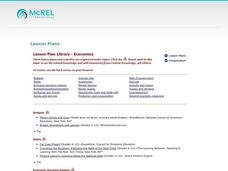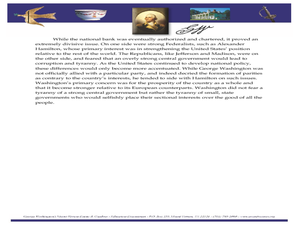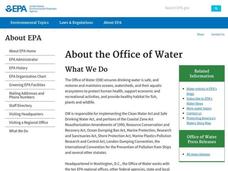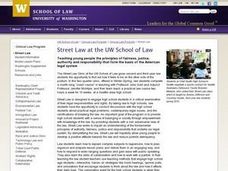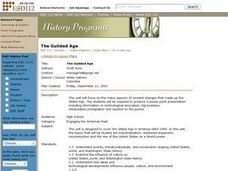Curated OER
Law & Ethics for Photojournalists
Students identify and discuss First Amendment rights, examine how to make sound legal judgements regarding photographs of private individuals, examine difference between public and private figures as far as libel law is concerned,...
Curated OER
Micro Economics - Personal Budgeting
Students explore the real world as it relates to money and how people use it. In this money management lesson, students jump into the real world as they role play with money through spending, saving, being married, single, having...
Curated OER
The Chinese Expulsion Act of 1880
Students examine the Chinese Expulsion Act of 1880. For this History lesson, students explore the issues of immigration and exclusion surrounding the Chinese Expulsion Act. Students will use a variety of primary sources to write an essay...
Curated OER
Turning the Tide on Trash: Marine Debris Curriculum
Seven pages of fascinating reading on marine debris preface the activities in this lesson plan. Four different activities are employed to simulate how the debris is distributed in the ocean and along beaches. Early ecology learners...
Smithsonian Institution
Students’ Response to 9/11—A Documentary Report
Young historians research the devastating attacks of 9/11 and use that information to script their own documentaries. The follow-up activity includes recording the documentary and conducting classmate interviews,
Curated OER
Using Political Cartoons to Understand Historical Events
Examine historical perspectives through the use of political cartoons. Learners complete analysis activities related to the president's title, the establishment of the national bank, and the Jay Treaty.
Curated OER
American Life
In this American Life activity and progress test worksheet, students respond to a total of 23 short answer, true/false, multiple choice, matching, crossword puzzle, and fill in the blank questions pertaining to American Life.
Curated OER
What is Public Use?
Explore the Fifth Amendment by examining the meaning of "public use" as learners read a scenario and role play their assigned parts to determine "public use." They also read Supreme Court Cases regarding the amendment and present their...
Curated OER
Turning the Tide on Trash: Marine Debris Curriculum
Six different lessons comprise this unit on marine debris. Science, language arts, social studies, and art projects make this an ideal interdisciplinary unit. The result will be well-informed future citizens who can help make a...
Curated OER
Living News: Classroom Materials
Young scholars explore controversial current events. In this Bill of Rights lesson, students research selected issues and examine the issues from different perspectives. Young scholars script and record news stories that feature their...
USA.gov
How The Supreme Court Works
Just how does a case come before the highest court in the land? A graphic flow chart unpacks how plaintiffs come before the Supreme Court. Graphics include background on the nine justices and just how many cases they actually hear each...
Curated OER
What Can We Learn about India from a Ten Rupee Bank Note?
The class finds and cites evidence showing India's unity in diversity and work to recognize some of the complex interactions of a civilized community. They read to understand how geography, history, politics, economics, beliefs, and...
Curated OER
Cartoons for the Classrooms: Wall Street
Open up an intriguing dialogue about Wall Street controversy using political cartoons! Background information gives context, including quotes from various newspapers about compensation caps, bonuses, and the growing disenchantment with...
Software MacKiev
WORLD BOOK - This Day in History for iPad
A simple but useful reference app, this resource provides short entries about historic leaders, entertainers, writers, inventors, and events of the past.
Curated OER
Individual Rights and Liberties: Free Speech
Students review free speech laws and the First Amendment in the Constitution. They discuss a current event involving free speech. They present the information to the class.
Curated OER
Comparing Foundations of Democracy
Students examine democratic values. In this democratic ideologies instructional activity, students discuss individual rights and rights of the group. Students also discuss the implications of the priorities made in democratic societies...
Curated OER
The Guilded Age
Students examine the Gilded Age in American history. Using the internet, they research the innovations, business, and immigration during this time period. They create a PowerPoint presentation to share their information with the class.
Curated OER
Fact and Opinion Pre-Test
In this fact/opinion worksheet, students complete 10 multiple choice questions. Students may click on a link to view correct answers.
Curated OER
Push/Pull factors in Immigration
Students explore the push/pull factors experienced by immigrant families. They interview a parent and an American about their family's immigration history. Students write a summary of the interview and compare the push/pull factors of...
Curated OER
Due Process of Law and the Jim Crow Era
Students analyze eight case studies of Supreme Court decisions regarding due process of law and their impact on American society in the early 20th century. They digest that although the 14th amendment was intended to give federal rights...
Curated OER
The First American Party System: Events, Issues, and Positions
Learners identify factors which lead to the development of the Federalists and Democratic-Republicans. They examine the writings of Thomas Jefferson and Alexander Hamilton as well. They discuss what elements are needed for an orgainized...
Curated OER
The War for Independence: 4th Grade
Here is a great interactive idea that may need a little refining. Students play 3 rounds, where they answer questions explaining how different countries have gained independence throughout history. While this resource has music and...
Curated OER
Race and Voting in the Segregated South
Learners examine the history of African American voting rights. In this voting rights lesson, students listen to a lecture on African American voting rights between the years 1890 and 1965. Learners respond to discussion questions...



